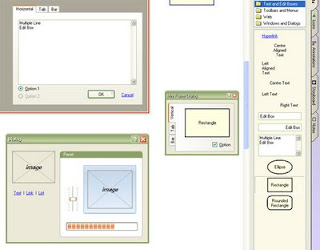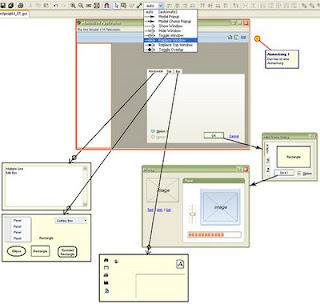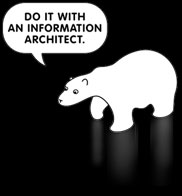
Conclusion: GUI Design Studio is an easy to learn but quite extensive prototyping tool. For $499 you get lot's of great features. Make complex prototypes in a few minutes. Nice, fast and easy.
(my other reviews)
GUI Design Studio is a graphical user interface design tool for Microsoft Windows that you can use to rapidly create demonstration prototypes without any coding or scripting. Draw individual screens, windows and components using standard elements, connect them together to storyboard operational workflow then run the simulator to test your designs.
Heute möchte ich das Prototyping Tool GUI Design Studio reviewen und euch, liebe THS-Leser, mal vorstellen.
Das GUI Design Studio hat wie alle anderen Tools auch, eine Bühne auf der man seine Prototypen "zusammenschrauben" kann und eine Bibliothek aus der man einzelne Komponenten auf die Bühne ziehen kann.
Etwas unkonventioneller Weise, ist die Komponenten-Bibliothek rechts angeordnet. Man gewöhnt sich sehr schnell daran, aber es ist auf den ersten Blick doch etwas ungewohnt. Etwas unschön ist, dass die verschiedenen Reiter, der wirklich sehr gut ausgestatteten Library vertikal verlaufen und man immer leicht seinen Kopf neigen muss, um sie lesen zu können.
Aus Usability-Sicht ist das suboptimal und von solchen kleinen Fehlerchen welche die Anwendung nicht ganz flüssig ablaufen lassen und einen immer wieder zum Nachdenken zwingen, gibt es ein paar.

Um einzelne Wireframes oder Entwürfe miteinander zu verlinken muss nicht programmiert werden. Es werden ganz einfach ein paar Pfeile gezogen und fertig. Das Programm unterstützt den Anwender sehr gut bei dieser Aufgabe. Hinter den Pfeilen steckt jeweils eine bestimmte Funktion (zB: Neues Fenster oder Zeige Darüber - hier alles frei übersetzt :).
Die einzelnen Systemfenster (vom Wireframe) lassen sich in der Simulations-Ansicht ganz einfach auch wieder schließen (rotes Kreuzchen). Diese Funktion bringt das Programm bereits mit und muss nicht händisch implementiert werden.

Mit GUI Design Studio lassen sich Dokumentationen als HTML, PDF und RTF erstellen. Der Output ist nicht besonders schön aber auf jeden Fall brauchbar. Gerade in der PDF Variante versucht die Software wirklich ein halbwegs gutes Dokument hinzubekommen. Es gibt vernünftige Überschriften, ein Inhaltsverzeichnis und natürlich alle Bilder - alles automatisch importiert und generiert.
Zusätzlich zu GUI Design Studio kommt gibt es noch einen kostenlosen GUI Design Viewer der quasi eine abgespeckte Version des Design Studios ist (keine Library, beispielsweise). Mit ihm lässt sich das exportierte Projekt betrachten. Anmerkungen werden ebenfalls übernommen. Der Viewer zeigt zusätzlich zum Abspiel-Modus aber auch die Bühne an, was manchmal etwas zu viel des Guten sein kann. Schließlich soll der Kunde nur den fertigen Prototyp und nicht den komplexen Aufbau sehen. Am Aufbau verändern kann man im Viewer aber nichts.
Die Download-Seite ist erfreulich übersichtlich. Es gibt sogar eine Dokumentation - etwas, was man bei anderen Prototyping Tools oft vergeblich sucht.
Hier geht es zu einem kurzen Demo Video.
Fazit
GUI Design Studio wird wohl in absehbarer Zeit keinen Design-Preis gewinnen. Was das Programm aber leistet, ist auf jeden Fall einen Preis wert. Die Software ist sehr robust und durchdacht. Sie läuft einfach gut, nichts hakt oder macht irgendwelche Mätzchen.
Die Anwendung unterstützt alle Standard-Funktionen wie Rückgänig machen, in den Vordergrund bringen und so weiter... Zusätzlich gibt es eine Menge sehr guter Shrotcuts.
Besonders positiv: mit der Dokumentation hat man sich wirklich Mühe gegeben.
Eine Einzellizenz kostet $499 (knapp 355 Euro). Das ist nicht gerade billig, aber auch nicht wirklich überteuert.
GUI Design Studio ist wirklich gut und meiner Meinung nach, seinen Preis wert. Gerade, wenn man mit der "Programmierung" ein wenig auf Kriegsfuß steht und lieber Striche zieht als if-else Konditionen schreibt sollte man sich das Programm unbedingt mal ansehen.
Reviews










